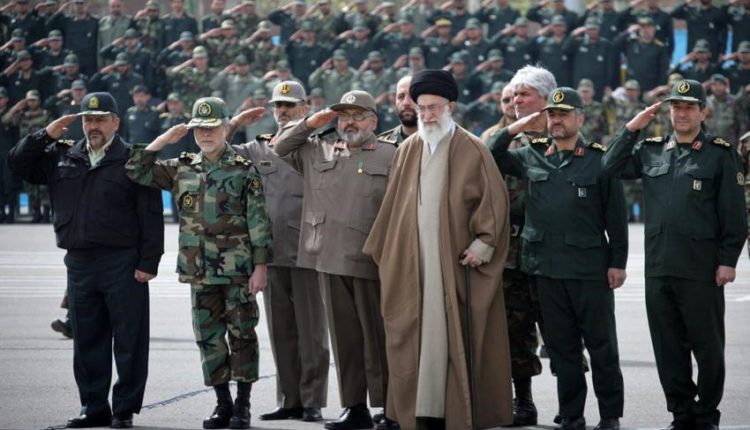After ISIS: The Threat of Iran’s IRGC
The Daily Caller
April 14, 2017 – Mohammad Amin
As the main bases of the terrorist group Islamic State (ISIS or Daesh) fall like dominos, and as the threat of that “caliphate” with territorial claims gradually wanes, a much more frightening monster, the Iranian regime’s Islamic Revolutionary Guard Corps (IRGC), emerges in the landscape of the Middle East.
As the main bases of the terrorist group Islamic State (ISIS or Daesh) fall like dominos, and as the threat of that “caliphate” with territorial claims gradually wanes, a much more frightening monster, the Iranian regime’s Islamic Revolutionary Guard Corps (IRGC), emerges in the landscape of the Middle East.
The image conjures up the picture of the biblical monster Leviathan, whose name inspired the title of Thomas Hobbes’s seminal work on political philosophy.
The IRGC, the Leviathan of Terror, which has the financial and military resources that exceed the wildest dreams of ISIS, now lurks in the Middle East. Its tentacles extend well beyond the geographical borders of Iran. While ISIS claimed parts of Syria and northern Iraq, the IRGC’s Shiite militias have an extensive presence in almost every country in the region.
In Iraq, the IRGC controls the Badr Organization, the al-Nojaba Movement, the Asa’ib Ahl al-Haq, Kata’ib Hezbollah, Kata’ib Imam al-Ali, Sarya al Khorasani, Kata’ib Seyed al-Shohada, Liwa Abu Fadl, Liwa’a Zulfiqar and Harakat al-Abdal. There are many other smaller offshoots.
The IRGC also has control over the Ansarollah (Houthis) in Yemen, the Hezbollah in Lebanon – which has conducted numerous terrorist attacks in the region and around the world – the Tayyar al-Amal al-Esmali in Bahrain, the Islamic Jihad and the Saberin in Palestine, the Islamic Revolutionary Guards in Egypt, the Kuwaiti Hezbollah, the Fatemiyoun Brigade in Afghanistan and the Zeinabiyoun Brigade in Pakistan.
These are the tentacles of the IRGC whose heart beats in Tehran. A significant portion of oil revenues obtained by the Iranian regime constantly funds these militias, with devastating consequences for the region and the security of western nations.
A large percentage of these militias’ costs are paid through revenues obtained by business ventures run by the Iranian Supreme Leader Ali Khamenei’s Setad, the IRGC Cooperatives, the Imam Khomeini Relief Foundation, the IRGC Basij Cooperative and a share of the government’s budget.
The main Iranian opposition the National Council of Resistance of Iran (NCRI) has revealed a list of 31,690 Iraqi mercenaries of the IRGC, all of whom receive their salaries from Iran.
Last year, U.S. military officials said that as many as 100,000 Iranian-backed Shiite militia are now fighting on the ground in Iraq, “raising concerns that should the Islamic State be defeated, it may only be replaced by another anti-American force that fuels further sectarian violence in the region.”
In Yemen, the IRGC shoulders the bulk of the costs for the Houthis who have waged a bloody war against the central government. The Houthis’ ballistic missile arsenal and armed drones have been supplied by the Iranian regime.
The militia is also using a new weapon that is raising fears of seaborne attacks on both military and commercial shipping in the region. “The weapon is an Iranian-designed remotely piloted small boat filled with explosives, a defense official” told the Washington Times last month.
In Bahrain, “U.S. and European analysts now see an increasingly grave threat emerging: heavily armed militant cells supplied and funded, officials say, by Iran.”
The Lebanese Hezbollah, according to its current secretary-general Hassan Nasrallah, receives all of its money and weapons from Iran. As far back as October 8, 2013, the French daily Le Figaro cited Lebanese sources estimating that Iran has provided Hezbollah with a staggering $30 billion dollars over the past 30 years.
Similarly, analysts estimate that Tehran’s annual financial backing amounts to $1.5B-$3B for dozens of Shiite militias in Iraq, $1.5B-$2.5B to the Houthis in Yemen, $1B-$1.5B to the Lebanese Hezbollah, $150M to the Afghan Fatemiyoun (who also fight in Syria) and another half a billion dollars to militias peppered across the Gulf states.
Alarmingly, these figures do not even include the mindboggling costs incurred by Iran for its involvement in the massacre of the Syrian people. By some estimates, the IRGC spends nearly $8B on its militias and mercenaries around the region, excluding Syria. These terror entities inflame sectarian tensions and set the stage for the growth of groups like ISIS.
Unless the Iranian regime, the IRGC and their myriad of extremist militias are expelled from regional countries, violence will hobble the Middle East, with catastrophic spillover effects for the world.
The Leviathan of Terror will only survive through constant expansion and regeneration in the Middle East. It will only die if it is contained within the borders of Iran.
As an essential first step in that direction, the Trump administration should designate the IRGC as a Foreign Terrorist Organization (FTO). Failure to adopt this critical measure will only serve to embolden the regime while the region and the wider world continue to grapple with the menace of religious extremist and terrorism.
Mohammad Amin is an analyst in Iranian affairs and fellow at the Paris-based Middle East Research Foundation. He tweets at @economieIran


Comments are closed.